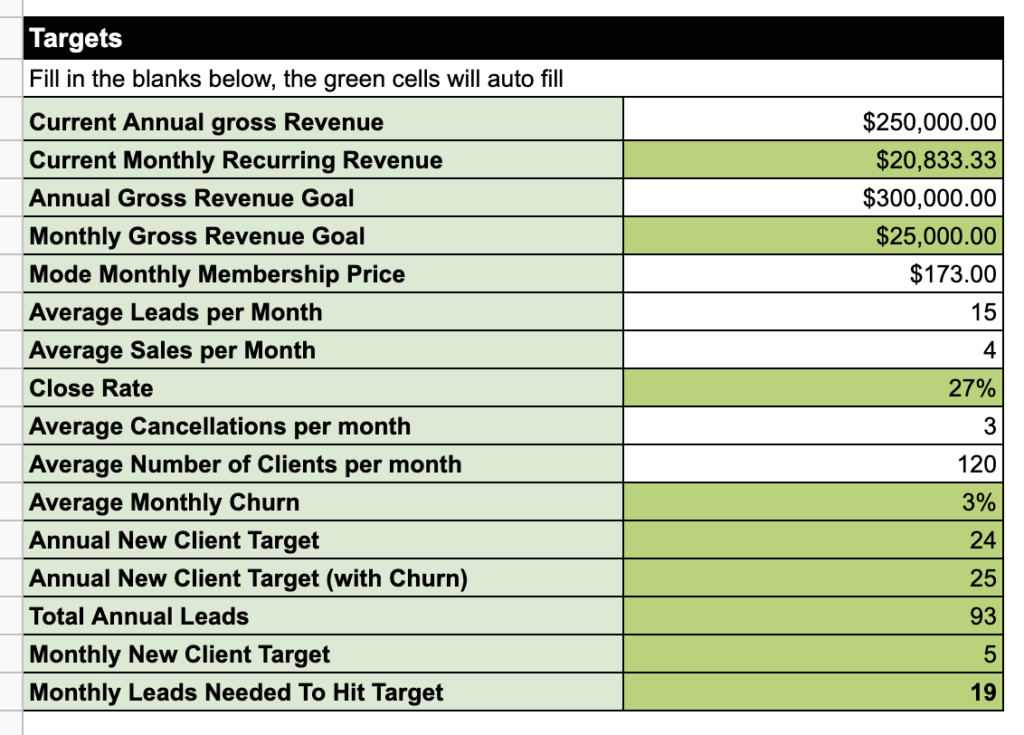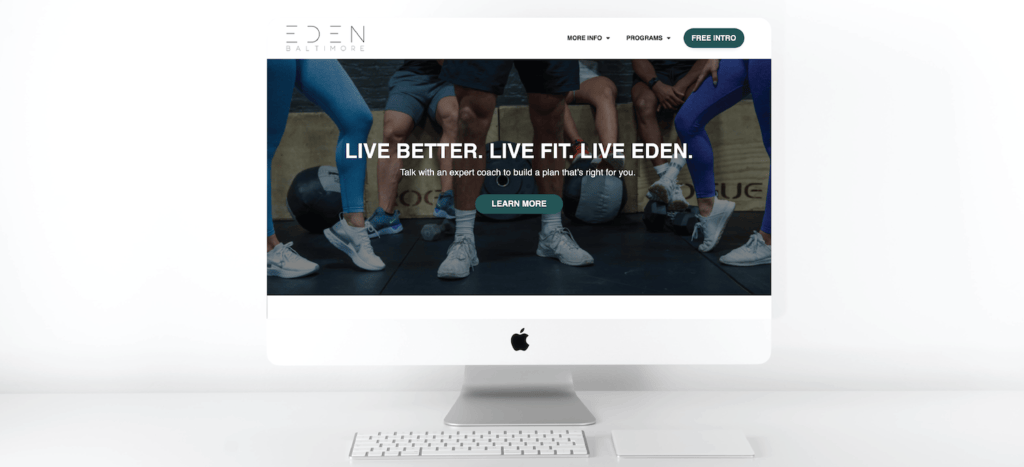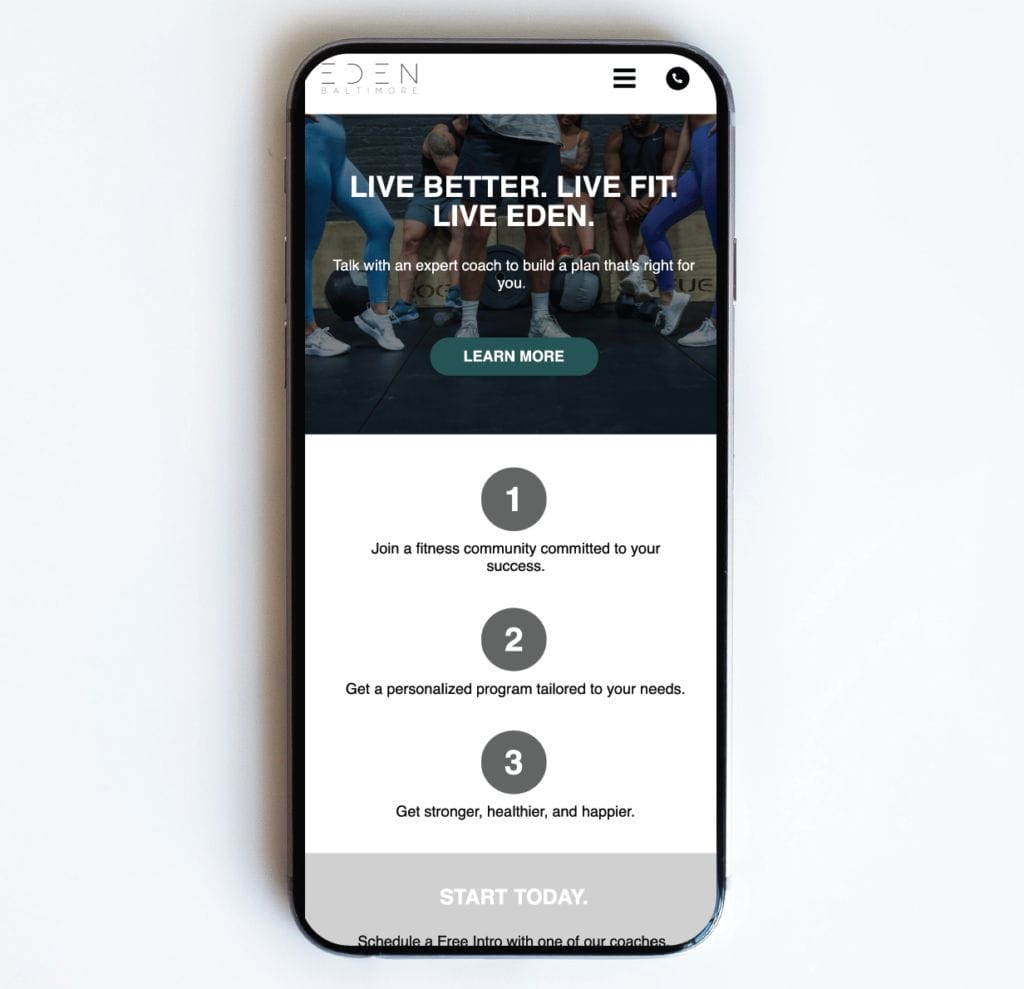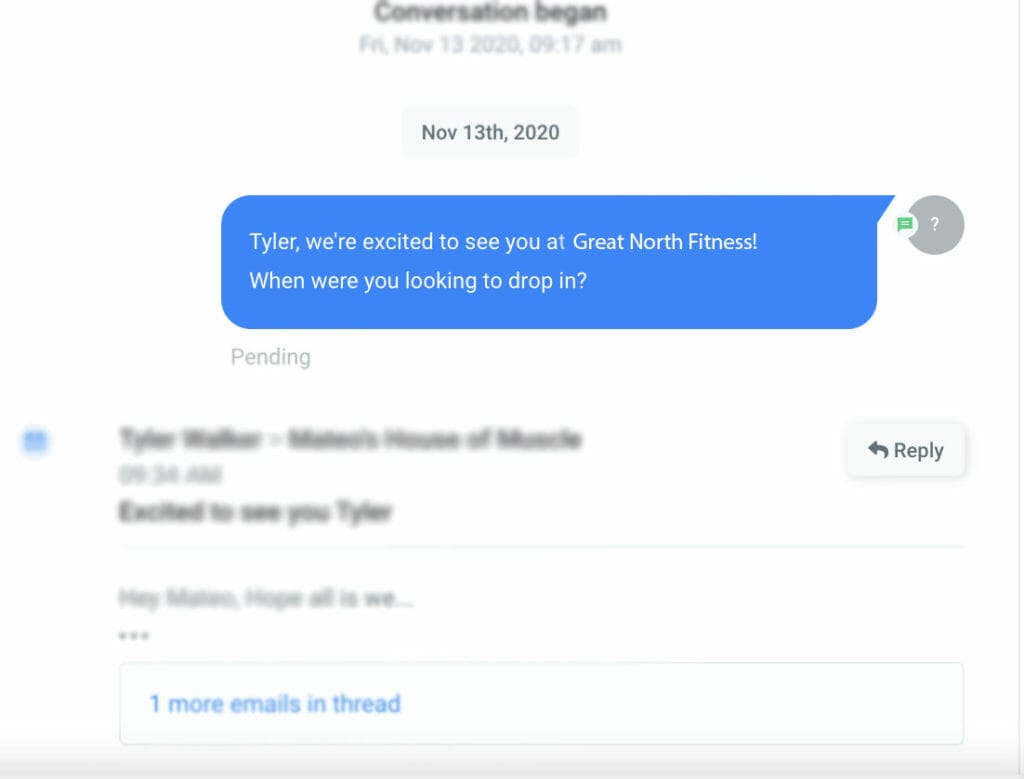Your 2021 Internet Marketing Plan
Do you have an internet marketing plan for your gym business in 2021?
If not, you’re falling behind by the day.
But don’t worry: We can get you up to speed—fast.
All you need to do is read this article, download the accompanying workbook and fill it out. We’ll walk you through it. At the end, you’ll have a solid internet marketing plan that will ensure your gym is packed with amazing, high-value clients in 2021.
Below, we’ll tell you exactly how to calculate key marketing numbers and set your goals for the year. Then we’ll talk about the three fundamentals of marketing success. After that, we’ll help you optimize your website for lead conversion.
We’ll finish by supplying the action steps you need to take to implement a plan that includes search engine optimization (SEO), pay-per-click advertising, retargeting, referral strategies and much more.
All this will help you maximize interest in your gym and make more sales—and you can use the workbook to review your internet marketing plan annually.
Start by downloading Your 2021 Gym and Personal Training Internet Marketing Plan. You can use Page 2 to make any notes and list action items as you read this post.
Setting 2021 Internet Marketing Goals

We’re going to start with the big picture and then work backward to determine exactly how many leads you need to generate to live the life you want to live. We’ll come up with hard numbers based on your unique business and your goals.
On Page 4 of the workbook, you’ll see an example of this calculation, and you can access an editable copy of the spreadsheet here.
What Do You Need to Gross?
To start creating your 2021 internet marketing plan, we’ll use current financial numbers and goals to figure out exactly how many leads you need to get each month.
Pull out the spreadsheet and fill in the white boxes:
- Current annual gross revenue.
- Annual gross revenue goal.
- Mode monthly membership price.
- Average leads per month.
- Average sales per month.
- Average cancellations per month.
- Average number of clients per month.
When that info is in place, the spreadsheet will calculate the rest of the numbers for you.
In the example in the workbook, a gym owner wants to add $50,000 in gross annual revenue, or $4,167 per month. The owner currently gets 15 leads per month and sells to four of them for a close rate of 27 percent.
Given an average membership price per month of $173, the gym needs 24 new members to hit the revenue goal—but a few members leave every month, so we include churn rate: The gym owner needs six new clients per month to replace cancelled members and increase total members. The close rate of 27 percent kicks out a lead requirement of 23 per month.
That number is key: You can use it to inform your lead-generation strategies, and it will prevent you from overspending. And if you improve on your current close rate? You’ll need fewer leads. We’ll tell you exactly what you can do to make more sales below.
Marketing Goals: Set Your Targets

It’s critical to do this marketing exercise and figure out the exact numbers you need to hit.
Without these goals, you’ll be swinging blindly and never know if you’re actually making progress.
With the goals clearly laid out, you can make a plan to hit them. Fitness entrepreneurs are driven to succeed—in workouts and in business—so clear targets are essential.
Think about it: These goals are like a wall-ball target. If the target is there, you’ll do everything you can to hit it.
Fill in the blanks on Page 6.
Do not skip this exercise!
Fundamentals of Marketing Success
With your target in place, we’ll review the fundamentals that are going to help you hit that target and generate the leads you need to accomplish your revenue goals.
It’s tempting to blow past the fundamentals to start working on ads and funnels and landing pages, but that’s a mistake. Spending a little time here will reduce your advertising costs, increase the quality and quantity of leads, improve your close rate, and drive up the efficiency of your marketing efforts.
We’ll build your foundation on three things: market, message and media.
Get the foundation in place before going further.
Define Your Market and Customer Avatar

Many gym owners think, “I want to attract everyone to my business.”
It sounds like a good plan, but here’s the reality: If you try to attract everyone, you won’t attract anyone because your messaging will be diluted. In the gym business, casting a wide net isn’t the best advice.
Instead, you must figure out exactly whom you want to attract to your gym. Chris Cooper, our good friend and the founder of Two Brain Business, has a simple exercise to help you identify your very best current clients.
Simply draw a line down a page. On the left side list the clients who bring you the most joy. On the right, list those who spend the most money at your business. Circle the names that appear in both columns. Those are your best clients. You want more people exactly like this.
Next, figure out as much as you can about your best clients and find commonalities among them. You’re looking at demographics but also other factors such as hobbies, goals, habits, fields of employment and so on. Beyond that, you want to find out about their fears, frustrations and aspirations. Use Page 8 of the workbook to make notes.
With that research behind you, you’ll be able to create an avatar—your perfect client. Describe this person in detail—you can even give the avatar a name if you like. You should know exactly what this client wants and why he or she will find it in your business.
Now you know who you’re going to be talking to. But what will you say?
Create Your Message
Use Page 9 in the workbook to determine your message. We have two key questions you must answer:
1. Why should someone choose to do business with you vs. the competition?
2. What benefits do you offer that will resonate with your target client avatar?
Answering these questions will help you determine your competitive advantages as well as the aspects of your business that will appeal to your avatar.
For example, if your avatar is a very busy, family-oriented professional who is interested in weight loss, your 30-minute lunchtime boot camp will help him or her get results fast and be able to pick the kids up from school. You probably won’t need to offer two-hour Olympic weightlifting clinics every week at 4 p.m.
Here’s a phrase that will work magic for your business if you fill in the blanks:
“We help blank to blank by blank.”
Take a minute and fill in the blanks in that statement for your business. That’s your message distilled into just a few words. You’ll say it over and over and over again in creative ways across all your media platforms.
Here’s an example: “We help busy professionals to lose weight by offering 30-minute boot camp classes.”
Another example: “We help women between 30 and 50 prepare for endurance events through high-intensity training delivered one on one.”
Digital Media: How to Build a Hub That Converts

All your media should be designed to do one thing: Get people to your website. That’s where the magic happens.
Forget likes on Instagram and Facebook and YouTube. You just want to get people onto a site that will lead them into your funnels. That statement is true even if you meet people in person.
Make no mistake: Your website is focal point of all interactions. It is the make-or-break crux of all marketing. It must help people take the next step to purchasing.
Good websites help you make sales. Bad ones confuse and make people hit the back button. Below, we’ll lay out some key do’s and don’ts that relate to marketing.
For an in-depth look at gym websites, read “Our Guide to the Best Gym Website Design.”
Gym Websites: Things to Avoid
People need to know exactly what you do as soon as they land on your site, and the next step to purchase must be obvious.
That’s your website in one sentence.
But many gym owners muddle their digital marketing plan with things that aren’t needed. Sliders—aka carousels—are one of those things.
Scrolling images might look cool to you, but they confuse visitors and distract from the core content. In fact, they turn off people who have “banner blindness” and immediately tune out content like this. Worse, sliders are seldom mobile friendly and they can slow your site down.
If you have sliders on your landing page, get rid of them.
While you’re at it, get rid of workouts posts. Visitors don’t understand them, and they only serve to intimidate people. They don’t even properly represent a business that offers customization and huge degrees of personalization.
CrossFit.com taught gym owners to put workouts on the landing page—and that worked in 2010 when hardcore early adopters were looking for WODs that would make them vomit.
Now, you need to tell clients “this is for you,” not “it’s going to hurt a lot.” If your members rely on your site for workout posts, consider moving them to a “members areas” or finding another way to deliver the workouts. Don’t let prospective clients see them and say, “What’s a muscle-up?”
Along the same lines, rip out any “scary” images—anything that could intimidate a new person. Show happy versions of your avatar instead. You want “aspirational” characters who inspire but don’t intimidate. Go back to the exercise above and find the most photogenic clients who give you joy and pay the most money to your business. Then ask them if you can take some photos.
Now on to optimizing your website.
Website Essentials

1. Optimize the “above-the-fold” section.
All “above the fold” content—everything seen before scrolling—must serve a purpose. Each element must have a reason for being there. Keep the area simple, remove all distractions and highlight key elements. You want to limit choices here, not overwhelm.
Less is more. Creativity is not as important as clarity. Be direct, not clever.
2. Focus on your headline.
Remember your avatar and your message: “We help blank to blank by blank.”
People must be able to figure out what you do within seconds of landing on your page, and your headline does a lot of heavy lifting. It should speak to the problems your perfect clients face and offer solutions. It should be clear and succinct, and it should show value.
Here’s a good example: “Lose weight fast working out at home.”
Another good one: “Get stronger in 30 days.”
Here’s a bad one: “Come for the community, stay for the suffering!”
3. Refine your call to action.
Your website is designed to get people to take the next step. You need to make that step obvious by telling people exactly what to do early and often. This is where your call to action comes in.
Simply, you need a highly visible button that gives specific instructions with action-packed words like “click,” “book,” “get” and “reserve.” This button should be visible even as people scroll down your landing page.
The text on the button should offer value or motivate people to act now.
A classic in the gym world: “Book a Free Intro.”
Another good one: “Get Your Free Guide.”
One more: “Reserve Your Spot Today.”
A terrible one: “Want more info about all the great stuff we offer to kids, parents and seniors?”
When people click the button, use a submission form that collects info. Your system should store that info in a database, notify staff of the lead’s click immediately and feed the lead into nurturing sequences at the same time. All that should happen as your site is leading the clicker to an integrated appointment booking window or providing the promised resource.
For more detailed info on this topic, read “Our Guide to the Best Gym Website Design.”
Solving the Biggest Problem in Internet Marketing
Above, we told you that you’ll need fewer leads if you improve your closing rate. We’ll help you do that here.
According to Mobile Marketing Helper, 50-60 percent of calls are not converted, along with 80 percent of leads from webforms and other inquiries online.
This is a huge waste of money. And you can take very simple steps to reduce these numbers—and drive up your close rate.
You don’t even have to be clever or “good at sales.” You just have to do the work. Here it is:
1. Respond to leads quickly—in seconds or minutes.
2. Follow up with leads day after day after day.
The Harvard Business Review reported that over 63 percent of the companies in a study took more than an hour to respond to leads. That’s incredible considering Leadsimple.com reported that calling a lead within 5 minutes is 21 times more effective than calling after 30 minutes.
To put it simply, after a lead opts in on your site, speed of response is the best predictor of a closed transaction.
Here’s another key stat presented on Zoominfo: Over 90 percent of all converted leads are reached by the sixth phone call.
That means you need to respond to leads fast—and repeatedly. Persistence is rewarded, yet many people stop trying after a single call.
To make sure you don’t drop the ball, we recommend you respond immediately and set up a simple tracking system for leads. You can use a simple spreadsheet shared among staff or a more complicated system if you like.
Whatever path you choose, log your calls and contacts and note what happened. Assign follow-up tasks with reminders. Don’t let anything fall through the cracks.
If you do this, your close rates will increase.
Try this right now: Ask a friend to opt in on your site and see how long it takes staff to respond.
Will staff double-dial your friend right away? Will staff call several times? Are any text or email automations triggered?
If a staff member contacts your friend once two days after the opt in, you have a problem. If no one ever contacts the lead, you have a disaster.
Automations: Your Robot Digital Marketing Team

We can’t be clearer about this: Pick up the phone and call your leads at least six times.
But that’s not the only way you’ll try to make contact.
Automated text and email sequences should be triggered the second a lead opts in. These automations are no substitute for a real person picking up the phone, but they do provide backup and additional touch points.
Check out this info from Campaign Monitor: “Research shows that SMS open rates are as high as 98 percent, compared to just 20 percent of all emails. And, on average, it takes 90 seconds for someone to respond to a text and 90 minutes to respond to an email.”
So should you use text or email? Use both to double down—but make your life easier by ensuring you have an automated, integrated, two-way SMS system in place. (Gym Lead Machine provides both automated SMS sequences and two-way texting on our platform.)
Your 2021 Internet Marketing Action Plan

Now that you’ve got your market, message and media dialed in, it’s time to take action.
Review Page 12 of our workbook: The Digital Dominance Method. There are six areas you can focus on.
1. SEO
- Strong copy.
- On-page conversion optimization.
- Site speed.
- Blogging and content.
- Reputation management.
2. Pay Per Click (PPC)
- Facebook ads.
- Instagram ads.
3. Retargeting
- Facebook retargeting.
- Google Display Network.
4. Online Directories and Reviews
- Yelp.
- Google My Business.
- Better Business Bureau.
- Facebook reviews.
5. Referral and List Activation
- Email marketing.
- Gift cards.
- Newsletters.
- Athlete check-ins.
6. Media
- Social media.
- Blogging.
- Podcast.
- YouTube.
Prioritize and Act
With all those elements available to you, fill out Page 13 in the workbook. Determine the top 3 things that will move the needle. Perhaps consider areas of obvious weakness where a little effort can bring a great reward.
Will you focus on generating a host of great Google My Business reviews? Will you fire up a blog that brings people to your site? Will you spend money on ads? Will you start sending a newsletter to your email list regularly?
List the three things that will bring the greatest reward. Then, on the bottom half of the page, list the people on your team or external experts you need to meet with to get moving.
Maybe you need to talk to a staff member about contributing a blog every week, or perhaps you need to talk to your client success manager about a process to build a Yelp review into your client journey.
Or maybe you need to contact an outside expert who can set you up with two-way SMS, professionally written nurturing sequences and a website that’s clear, fast and optimized for conversion. (That would be Gym Lead Machine: Click here to book a call.)
Whatever you decide to do, take action immediately. The clock is ticking, and the leads are clicking. Don’t let them grow cold and sign up with your competitors. Take action now!
We’ve laid out everything you need to have in your 2021 internet marketing plan. All you have to do is review your workbook, implement the plan and reap the rewards.






